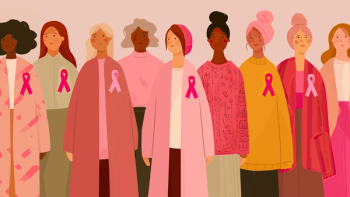
Know Your Treatment Options for Kidney Cancer: ‘Every Patient Is Different’
An expert explains the various treatment options available for a patient who is diagnosed with a small renal mass.
With kidney cancer rates on the rise in the U.S., it’s important for patients to understand treatment options for renal masses.
The number of kidney surgeries has also increased proportionally to incidence – the causes of which may be attributed to aging and obesity.
At the recent CURE® Educated Patient® Kidney Cancer Summit, Dr. Brian M. Shuch explained the various treatment paths a patient may go down after receiving a diagnosis.
Patients with stage 1 kidney cancer – with renal masses less than seven centimeters – may need a different type of treatment plan depending on their patient and tumor factors, explained Shuch, who is an associate professor of urology, director of the Kidney Cancer Program and the Alvin & Carrie Meinhardt Endowed Chair in Kidney Cancer Research at UCLA.
Treatment Is Not ‘One Size Fits All’
“As they say, if all you have is a hammer, everything looks like a nail,” Shuch said in an interview with CURE®. “And there's always been a knee-jerk reflex in the field to treat everyone with a hammer. And as we know, every patient is different. Every tumor is different. Every person's urologic cancer doctor might be different. Everyone brings different perspectives. But if the physician is not talking about all these options, then you're not sure they have every tool in their tool belt.”
It’s best for patients to not rush off to receive treatment with the first provider they speak to, and to make sure they’re asking as many questions as possible and receiving more than one opinion.
Understanding the Factors to Find the Most Effective Treatment Option
Once a patient has been diagnosed, their next steps may be determined by factors like age, life expectancy, operative risk, histology, patient preference, tumor size/growth and more. Depending on how they measure in each of these different areas, intervention may be more favorable than management.
“If you had a biopsy showing histology which it looks to be more aggressive, or if the tumor is actually growing, then you should strongly favor intervention,” Shuch explained.
It’s also important for patients who are at high-risk of death, such as older patients with competing medical issues, certain strategies can be employed to limit death. These may include smoking cessation, weight loss and colonoscopies.
“But that's the real teachable moment – to try to get them to modify those risks,” Shuch said.
What Are the Main Goals of Treatment?
The number-one priority of treatment for small renal masses is cancer control, Shuch said. After that, the goal is organ function preservation, meaning trying to minimize morbidity to the kidney, the adrenal and the ribs.
“Number three is cosmesis – trying to get your patients back to the beach and continue their modeling career, and also minimize downtime so they can get back to work quickly,” he added.
With the goals and factors in mind, treatment could be thermal ablation, partial nephrectomy or radical nephrectomy.
Radical Nephrectomy
A radical nephrectomy is when a patient’s entire kidney is removed (along with the entire tumor). It is the historic mainstay of therapy and would be a better option for older or more frail patients, and/or someone with a slightly larger tumor.
“I will say that the adrenal can be spared almost 95% of the time,” Shuch said. “if the tumor is really touching the adrenal – and you don't want to get too close to it – Yes, we could take part of the adrenal or the whole adrenal, but we try to minimize that. But basically, we remove the kidney (and) we never actually see the tumor, because we just keep it encased in a nice a collection of fat.”
This approach completely removes the tumor – checking off the priority of cancer control. It also allows for organ preservation so long as the other kidney is fully functioning. Most patients in the U.S. have a tumor that’s less than seven centimeters, which allows for a radical nephrectomy to be done. Most surgeries can be done minimally invasively, and patients can expect a three-to-five-day hospital stay and 2.5-hour surgery.
Partial Nephrectomy
Patients who are younger, have familial or genetic syndromes and/or reduced kidney function – among other factors – may be a good candidate for a partial nephrectomy. This is when part of the kidney is removed.
“Historically, it was for imperative indications when patients really would have multiple kidney tumors or have poor kidney function, so we just removed the tumor with a little rim,” Shuch said. “We've been taking less than less wire rims to preserve more kidney function.”
Much like a radical nephrectomy, with this option, removing the tumor alone would likely be curative and safe for the patient and can spare a significant amount of the kidney. However, Shuch added, “there are additional risks due to bleeding and leakage from the kidney, which is called the urine leak.”
Patients should expect a one-to-two-day hospital stay and a three-to-five-hour surgery for a partial nephrectomy.
Thermal Ablation
Thermal ablation is when extreme temperatures, with freezing (cyroablation) or heating (radiofrequency or microwaves), to destroy a tumor. This may become an option for patients who are older, frailer, can’t tolerate general anesthesia or have access to a multidisciplinary care center, among other factors.
“If the tumor is small, it could be easily accessible, and you can completely destroy it,” Shuch said. “And that would be your main priority. Number two is to know will the ablation zone cause harm to the surrounding structures, being if the needle is going to get into the lung, or it's potentially going to maybe damage the collecting system and you're going to have issues or potentially damaged renal vein or hilum. Clearly you don't want to do that. And then cosmesis – a patient who's sicker and frail. If you can get them out of the hospital the same day, that would be an ideal approach.”
With thermal ablation, the follow up schedule is different from surgery, with increased imaging. A successful procedure is one after which there is no growth or enhancement of the tumor over time.
Avoiding Misinformation Is Crucial
Patients should stay properly informed and avoid false information as much as possible. Getting a second opinion from another health care provider can help patients become more well-informed. But above all, patients should know what resources to use. Cancer.gov, the Kidney Cancer Association and KC Cure are reliable sites to turn to, according to Shuch.
“Every patient is different. And in the absence of a randomized clinical trial, comparing different approaches, you know, we have to offer all the options to our patients to try to individualize care,” he said.
For more news on cancer updates, research and education, don’t forget to




